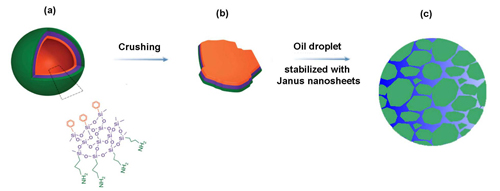A series of research progress in Janus colloidal materials
Complex colloidal materials with both tunable microstructure and composition are promising. Especially for those Janus materials possessing two different compositions compartmentalized onto the same objects, they can display superior performances. It is key to develop new methods to large scale synthesize the materials.
Supported by Chinese Academy of Sciences, Chinese Ministry of Science and Technology, and National Natural Science Foundation of China, the research group led by Prof. YANG Zhenzhong in State Key Laboratory of Polymer Physics and Chemistry ICCAS has achieved a series of progress in Janus colloidal materials. In 2008, Janus colloids were fabricated by simultaneous biphasic grafting of different polymer brushes onto the two parts of a colloid at a liquid/liquid Pickering emulsion interface by atomic transfer radical polymerization. The two parts of a colloid at a Pickering emulsion interface are separated into the two phases, which can be synchronously modified by ATRP in the two phases (Angew. Chem. Int. Ed. 2008, 47, 3973-3975). Similarly, Janus non-spherical colloids were prepared by asymmetric wet-etching the colloid which is frozen at the interface (Chem. Commun. 2009, 3871-3873). Moreover, Janus polymer/inorganic composite colloids were synthesized based on surface polymerization induced de-wetting onto a solid spherical surface and polymerization phase separation induced from a polymer shell in dispersions (Chem. Commun. 2010, 4610-4612; Macromolecules 2010, 43, 5114-5120). This method is promising due to their easy and large scale production of submicron sized composite ones with two components distinctly compartmentalized.
Recently, the group further extended definition of Janus to hollow spheres by materialization of an emulsion interface(Chem. Commun. 2011, 47, 1231-1233). Since the emulsion interface is Janus with both exterior hydrophilic and interior oleophilic surfaces, the interface acts as a temporal template to induce both the hydrophilic species and oleophilic species to self-organize at the interface and spontaneously face towards the external aqueous and the internal oil phases respectively. Shell thickness, microstructure and composition can be greatly tunable. Desired materials can be selected collected into the cavity of the Janus hollow spheres from their surroundings due to a favorable interaction. The performance proves the materials can find realistic applications in containers and controlled release. Janus nanosheets were fabricated by crushing the as-prepared Janus hollow spheres, which can be used as solid surfactants to better emulsify immiscible fluids. More interestingly, stable "dry fluid" droplets can be achieved in air after the external continuous phase elutes. Further, functional Janus nanosheets can be derived by selective growth of materials onto desired sides for example paramagnetic ones by adsorbing Fe3O4 nanoparticles, which can be manipulated with a magnet. The dispersed droplets can be therefore manipulated, and the Janus nanosheets are easily collected for reuse. The performance is promising in easy collecting oil or hazardous chemical spills. Janus nanosheets are also important in other areas for example composite materials and enhanced oil recovery. After the result was published on Angew. Chem. Int. Ed. 2011, 50, 2379-2382, it was immediately highlighted by Nature China (http://www.nature.com/nchina/2011/110302/full/nchina.2011.17.html).

Schematic fabrication of the inorganic Janus nanosheets and their Janus performance as a solid surfactant.(Image by YANG Zhenzhong)





